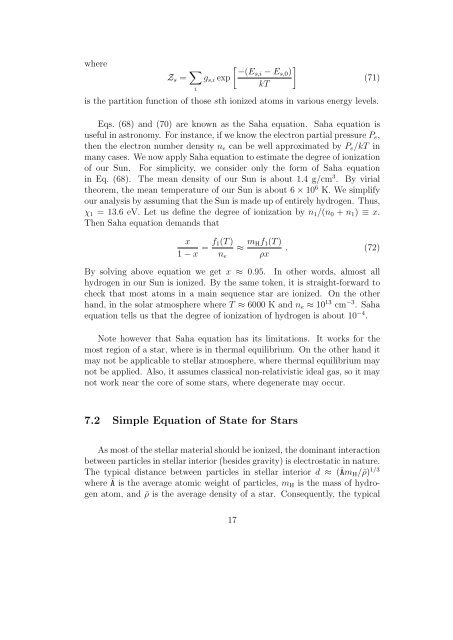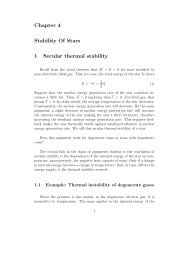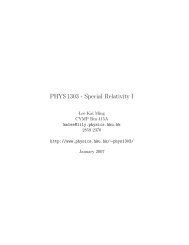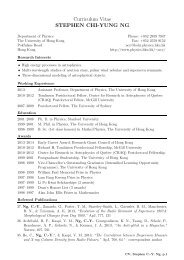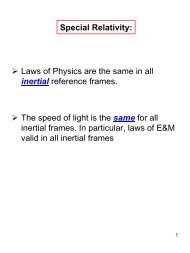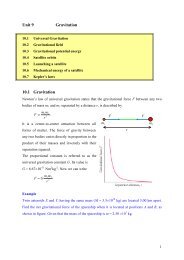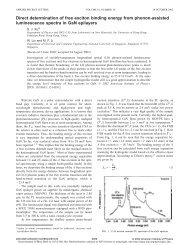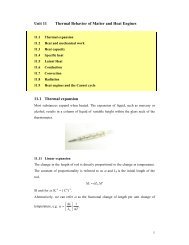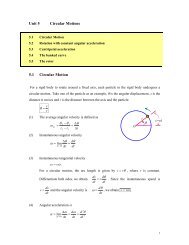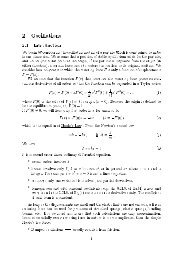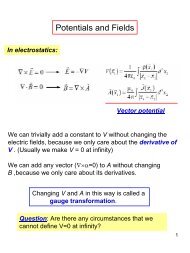Chapter 2 Stellar Structure Equations 1 Mass conservation equation
Chapter 2 Stellar Structure Equations 1 Mass conservation equation
Chapter 2 Stellar Structure Equations 1 Mass conservation equation
Create successful ePaper yourself
Turn your PDF publications into a flip-book with our unique Google optimized e-Paper software.
where<br />
Z s = ∑ i<br />
[ ]<br />
−(Es,i − E s,0 )<br />
g s,i exp<br />
kT<br />
is the partition function of those sth ionized atoms in various energy levels.<br />
(71)<br />
Eqs. (68) and (70) are known as the Saha <strong>equation</strong>. Saha <strong>equation</strong> is<br />
useful in astronomy. For instance, if we know the electron partial pressure P e ,<br />
then the electron number density n e can be well approximated by P e /kT in<br />
many cases. We now apply Saha <strong>equation</strong> to estimate the degree of ionization<br />
of our Sun. For simplicity, we consider only the form of Saha <strong>equation</strong><br />
in Eq. (68). The mean density of our Sun is about 1.4 g/cm 3 . By virial<br />
theorem, the mean temperature of our Sun is about 6 × 10 6 K. We simplify<br />
our analysis by assuming that the Sun is made up of entirely hydrogen. Thus,<br />
χ 1 = 13.6 eV. Let us define the degree of ionization by n 1 /(n 0 + n 1 ) ≡ x.<br />
Then Saha <strong>equation</strong> demands that<br />
x<br />
1 − x = f 1(T )<br />
≈ m Hf 1 (T )<br />
n e ρx<br />
. (72)<br />
By solving above <strong>equation</strong> we get x ≈ 0.95. In other words, almost all<br />
hydrogen in our Sun is ionized. By the same token, it is straight-forward to<br />
check that most atoms in a main sequence star are ionized. On the other<br />
hand, in the solar atmosphere where T ≈ 6000 K and n e ≈ 10 13 cm −3 . Saha<br />
<strong>equation</strong> tells us that the degree of ionization of hydrogen is about 10 −4 .<br />
Note however that Saha <strong>equation</strong> has its limitations. It works for the<br />
most region of a star, where is in thermal equilibrium. On the other hand it<br />
may not be applicable to stellar atmosphere, where thermal equilibrium may<br />
not be applied. Also, it assumes classical non-relativistic ideal gas, so it may<br />
not work near the core of some stars, where degenerate may occur.<br />
7.2 Simple Equation of State for Stars<br />
As most of the stellar material should be ionized, the dominant interaction<br />
between particles in stellar interior (besides gravity) is electrostatic in nature.<br />
The typical distance between particles in stellar interior d ≈ (Ām H /¯ρ) 1/3<br />
where Ā is the average atomic weight of particles, m H is the mass of hydrogen<br />
atom, and ¯ρ is the average density of a star. Consequently, the typical<br />
17


